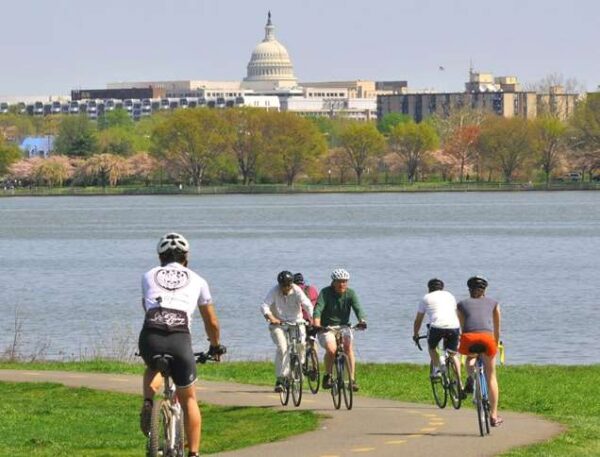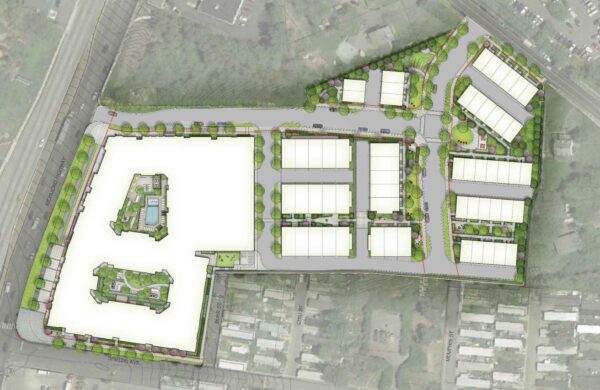Just in time for the summer tourist season, Fairfax County is stepping up its efforts to promote the amenities in its southeastern area, providing a discount pass for admissions and more.
County and tourism officials, along with staff of George Washington’s Mount Vernon, touted a new digital pass yesterday (Wednesday) that gives visitors at historic sites and other destinations 20% off admissions and other deals.
Launched last December, the branding campaign is called “Potomac Banks: Explore Fairfax South” and was developed by the digital marketing agency Streetsense. It was showcased during a media event outside the first president’s mansion overlooking the Potomac River.
“Fairfax South is the place to be,” said Mount Vernon District Supervisor Dan Storck, who started the Mount Vernon Tourism Task Force in 2019 that led to the branding.
Storck, who was a President Abe Lincoln re-enactor for 25 years, said his love of history was a driving force in showcasing the region’s amenities.
An original marketing push rolled out in February 2020, but the COVID-19 pandemic soon took hold in the U.S., particularly damaging the hotel and restaurant industries, Storck said.
The effort also includes one year of marketing with a business development campaign, said Barry Biggar, president and CEO of Visit Fairfax, the area’s official tourism organization.
“Now the real work begins,” he said.
Savings pass launched to promote region
The pandemic-induced delay meant the marketing effort could include a new feature: the Potomac Banks Savings Pass, a $46 pass that gives discounted admission to partnering sites, including George Washington’s Mount Vernon, George Mason’s Gunston Hall and Woodlawn & Pope-Leighey House.
The pass, which has a $25 version for kids ages 6 through 11, also provides deals on tours, gifts and activities at sites such as the National Museum of the U.S. Army, the Workhouse Arts Center, G34.3 Brewing Co., Woodlawn Press Winery and Historic Huntley.
The pass is valid for 90 days, but once it’s first redeemed at a site, it lasts for seven days.
While Washington’s historic property has weathered the pandemic and had buses of visitors there yesterday, other sites will be able to cross-promote.
What do @mountvernon, @gunstonhall, and @woodlawnpopel have in common?
We are offering 20% off admission through the #PotomacBanks Savings Pass! See what other discounts are included: https://t.co/UXJ2vwy3j1
#VisitFairfax #VisitVirginia pic.twitter.com/d4NKBboimc
— Mount Vernon (@MountVernon) May 18, 2022
Fairfax County Board of Supervisors Chairman Jeff McKay said teachers and textbooks are amazing, but nothing can replace experiencing history in person, and there are historic assets right in people’s backyards to enjoy that people from across the world come to visit.
Biggar said there are plans to create the county’s first tourism improvement district in southern Fairfax County. He said it could be a model for the rest of the region.
According to Biggar, Fairfax County’s tourism dollars generate the most revenue for the Commonwealth of any jurisdiction. The county’s tourism industry generated more than $3 billion in 2019, and he projects it will reach $4.5 billion in five years.

An iconic resource along the Potomac River is turning 50.
The Mount Vernon Trail first opened on April 15, 1972. Half a century later, elected officials and others will gather to celebrate its storied history with activities for all ages.
Scheduled for 10 a.m. to 1 p.m. this Saturday (April 16), the 50th anniversary event at Daingerfield Island (1 Marina Drive) in Alexandria will feature giveaways, work demos, the National Park Service’s Junior Ranger Program, and more, according to an event page.
“The creation of the Mount Vernon Trail exemplifies how determined community members can help foster partnerships with government and the private sector to create a community asset that benefits all of us,” Mount Vernon Supervisor Daniel Storck said during a Fairfax County Board of Supervisors meeting yesterday (Tuesday).
The Friends of the Mount Vernon Trail credits volunteers as instrumental in creating the multi-use path, which now spans more than 18 miles across Fairfax and Arlington counties and Alexandria City:
On April 15, 1972, the first 4.5-mile stretch of the Mount Vernon Trail opened to the public. The gravel path ran from Belle Haven in Alexandria to the Memorial Bridge in Arlington and was the brainchild of two Alexandria women, Ellen Pickering and Barbara Lynch. In 1971, the two gathered over 700 signatures on a petition to create a trail alongside the George Washington Memorial Parkway.
The National Park Service was sympathetic to the plea and agreed to provide the right-of-way, gravel, and tools if Pickering and Lynch could provide volunteers to do the work. So Pickering and Lynch organized 40 volunteers, and every Saturday that winter they spread gravel. In total, 400 recruits spread 4,200 tons of gravel, contributing 5,300 hours of labor to start the trail that would become a vital recreational and transportation corridor in the region.
Storck said the trail serves as an essential artery for the Mount Vernon District, an 18.5-mile anchor for the region’s trail network with approximately 1 million annual users.
In addition to Storck, speakers at the celebration will include:
- George Washington Memorial Parkway Superintendent Charles Cuvelier
- Friends of the Mount Vernon Trail President Judd Isbell
- Arlington County Board Chair Katie Cristol
- Alexandria City Councilmember Sarah Bagley
Several community, transportation, and governmental groups are also expected to attend, including BikeArlington, WalkArlington, Capital Bikeshare, GO Alex, East Coast Greenway, Capital Trails Coalition, Friends of Dyke Marsh, and the Rosslyn Business Improvement District.
The event is free and open to the public.
The first 4.5 miles of the Mount Vernon Trail opened 50 years ago. Join us for a celebration this Saturday and visit the @TrailsCoalition table to see how the MVT will be part of an 881 mile trail network in the future. Details and registration are at https://t.co/pn7Aq6OJX6 pic.twitter.com/CkdeXlqgUU
— Friends of the Mount Vernon Trail (@MtVernonFriends) April 13, 2022
Photo via National Park Service

The Fairfax County Board of Supervisors and other Northern Virginia officials are looking for ways to help commuters during a lengthy planned shutdown of Metro’s Yellow Line for rehabilitation work.
The Washington Metropolitan Area Transit Authority will stop service on a key section of the line for seven to eight months to repair a Yellow Line bridge over the Potomac River and tunnels that are over 40 years old.
The project is scheduled to start in September and finish in the spring. The shutdown will be between the Pentagon and L’Enfant Plaza stations.
“The seemingly endless stream of shutdowns, delays, and missed completion dates is making Fairfax County commuters increasingly frustrated and hampering Metro’s ability to rebound from pandemic ridership numbers,” Chairman Jeff McKay said during the board’s meeting yesterday (Tuesday).
The board agreed to write a letter urging WMATA to accelerate the project timeline and provide more alternatives for commuters, such as improved bus service and parking fare reductions at Yellow Line stations during construction.
McKay also encouraged Virginia Railway Express to play a “lead role in possibly providing relief in ways like fare incentives for Yellow Line riders.”
The work is occuring at the same time the new Potomac Yard Metro station is being connected to rail lines as part of a six-week project. The station is slated to open this fall, following delays.
McKay said that while safety must be the highest priority, he’s concerned about the effects of the shutdown, especially as people return to the workplace. Metro service has already been significantly reduced systemwide for months since a train derailed in Arlington County in October.
“WMATA needs to find a way to shorten that timeframe and do a better job of at least getting our commuters through that bottleneck, which is frankly, for us, Alexandria,” Mount Vernon District Supervisor Dan Storck said.
The Mount Vernon District borders the City of Alexandria and includes the Huntington Metro station at the end of the Yellow Line.
“That’s not a criticism of Alexandria,” Storck added. “It’s just the amount of people that’s going to go through it is even more than in the past.”
WMATA spokesperson Sherri Ly said the authority is working with its regional partners, businesses and the community to create a mitigation plan, including bus service enhancements and changes to parking policy for the project’s duration.

A major residential project by Lennar Corp. that has been years in the making has been approved for the Penn Daw area.
The owners of the 7.4-acre property — which has 16 parcels owned by Penn Daw Properties and Michael Strassburg — hope to redevelop five single-family homes and a commercial building with up to 46 stacked townhouses, 35 townhouses and a 385-unit apartment building that would stand up to seven stories tall.
The Fairfax County Board of Supervisors unanimously approved the project, which required rezoning the property, at a Feb. 22 meeting. The project is located in the Penn Daw Community Business Center east of Richmond Highway and north of Shields Avenue.
Mount Vernon District Supervisor Daniel Storck said the county and applicant worked with many stakeholders to move the project — which he said has been “a long time coming” — forward. He noted that the project is one that “tells you that things are changing at Richmond Highway.”
“We leave no one behind as we redevelop this area,” he said.
The developer’s agent, Lynn Strobel, called the project a “gateway site.” She said the applicant intentionally moved utilities underground to improve the aesthetics of the site and worked through a number of typographical challenges to activate the site with appropriate residential elements.
A parking garage for the apartment building and 22 street parking spaces are planned. The applicant successfully sought a 26% reduction in parking spaces as required by the county. The project is next to Penn Daw Trailer Park, a 90-unit mobile home park that could also be slated for redevelopment in the future.
The site, which is near the future Penn Daw BRT station, includes a two-way cycle track and road connections to neighboring areas. A network of public open spaces, including an urban plaza along the frontage of Richmond Highway in front of the multifamily building, is also planned.
In recent years, the county has stepped up efforts to encourage revitalization of the Richmond Highway Corridor.
The Fairfax County Board of Supervisors approved the project’s eligibility for tax abatement through the county’s Economic Incentive Program (EIP), which is designed to encourage revitalization of high-demand areas like the Richmond Highway Corridor.
Storck said those economic incentives were instrumental in pushing the project forward.
“In this case, we will see our investment paying off with a project that would not have been possible otherwise.”
At a Feb. 22 meeting, the board unanimously approved tax abatement efforts to help the project proceed.
The developers will be able to take advantage of roughly $1.3 million in tax abatement per year over 10 years. Staff noted that the proposed development is near a future Bus Rapid Transit station on Richmond Highway.
“In the case of this site, the property owners have sought redevelopment for over ten years but we’re strongly challenged by consolidation issues, among others,” according to a staff memo.
In September 2020, the county instituted the EIP program for the county’s five Commercial Revitalization Districts and Commercial Revitalization Areas, which include Richmond Highway, McLean, Seven Corners and Annandale. The program gives developers regulatory and financial incentives to proceed with development and revitalization efforts.
In 2015, the county worked with Prince William County, the Virginia Department of Transportation and the Virginia Office of Intermodal Planning and Investment on an 18-month study to revitalize the corridor. The plan — called Embark — sought to bring transit-oriented development to the area along with a surge in Bus Rapid Transit.

Fairfax County has committed to becoming carbon-neutral by 2050, and now, it has a plan to achieve that goal.
The Fairfax County Board of Supervisors accepted the county’s first-ever Community-wide Energy and Climate Action Plan (CECAP) when it met on Tuesday (Sept. 14).
First proposed by the board’s Environmental Quality Advisory Council in 2018, the plan features an inventory of the county’s greenhouse gas emissions and recommendations for how to curb them so the community can realize its aspirations of carbon neutrality.
“Together, the strategies and actions are intended to power individuals and organizations within the community, to engage in, lead, and champion the emissions reduction needed to achieve county-wide carbon neutrality,” Mount Vernon District Supervisor Dan Storck said, reading from the board matter he issued. “Climate change is a major existential crisis already causing major impacts in Fairfax County.”
The final report calls on both the county and its citizens to take far-reaching, significant actions.
Proposals include cutting the use of fossil fuel-burning cars, installing solar panels at home, creating more through recycling and composting programs, adopting more stringent green-building policies, and being a “conscious consumer.”
Storck’s motion passed 9-0, with Springfield District Supervisor Pat Herrity not present during the vote.
A few moments before the vote, Herrity said he was going to abstain due to concerns over timing, lack of proper community engagement, and cost, particularly in light of the ongoing COVID-19 pandemic.
“The economic outlook over the next few years is uncertain,” Herrity said. “Our decisions don’t operate in a vacuum. This plan will have planned and unintended impacts on the economy and taxpayers. Beyond what I’m imagining will be a very steep cost to implement this plan, it will also have a very serious impact on the affordability of homes, increasing the actual cost as well as permitting and regulatory costs.”
The rest of the board countered that the county can’t afford to wait any longer to address the already-existing threat of climate change.
“The cost of doing nothing is significant, if not life-threatening,” Board of Supervisors Chairman Jeff McKay said. “And I think most responsible people who are paying attention to the subject and the science…most certainly get that.”
Storck, who helped spearhead the CECAP as chair of the board’s environmental committee, reiterated that county operations and schools only account for about 5% of Fairfax County’s carbon emissions. The remaining 95% of emissions come from the private sector and the general community.
As noted in a presentation that Storck delivered, transportation and commercial and residential energy consumption are the two largest sources of greenhouse emissions. Combined, those areas produce more than 90% of all emissions in the county.
As a result, while the county will have a leadership role, this new plan is about asking the community to take the necessary steps to curb emissions, Storck said.
“There will be no area, sector, or part of our society that won’t be impacted [by the reduction goals in this plan],” he said. “How much? That’s largely a function of how aggressively we move forward.”
As the county worked to finalize the CECAP over the summer, the United Nations released a sobering report last month that said, even if future emissions are lowered, global temperatures will continue to rise until at least the middle of the 21st century, leading to more extreme weather and other worsening climate issues.
County staff told the board’s environmental committee in July that the CECAP’s implementation was already underway, a process that includes community outreach, public education, and an exhaustive review of existing county policies to see how they line up with the now-accepted plan.
Additional plans related to the initiative’s implementation, such as how the county can build on existing programs, will be presented to the board at an environmental committee meeting in early 2022.
Photo via Sandra Parra/Unsplash

